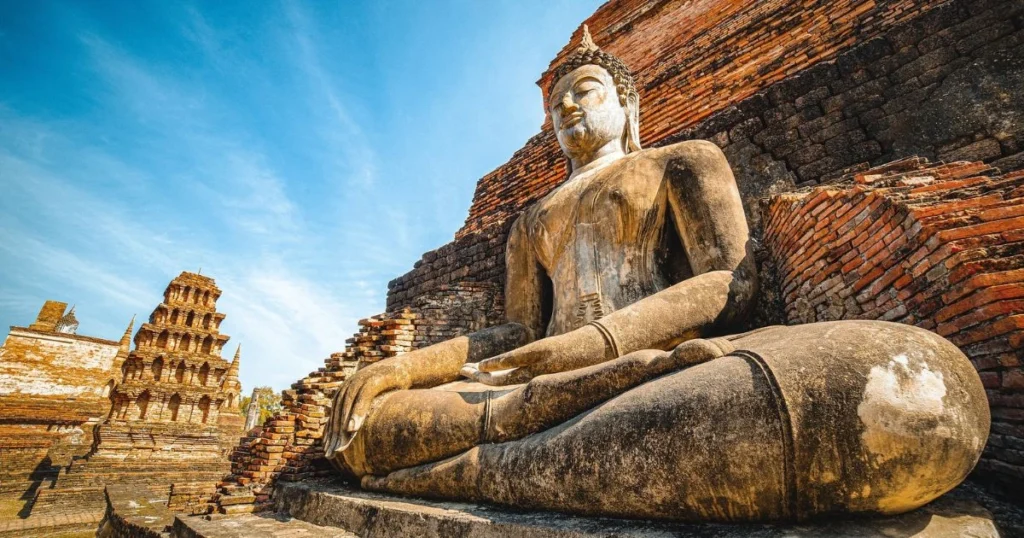The Ultimate Guide to the Best Time to Travel to Thailand
My first trip to Thailand was unforgettable. The tropical breeze felt like a warm hug. It made me realize this place was more than just a destination—it was an adventure waiting to change my life.
Choosing the right best time to travel to Thailand can make all the difference. Whether you dream of beautiful beaches, lively markets, or peaceful mountains, knowing the best travel seasons is key. It helps you plan an amazing trip.
This guide will help you understand Thailand’s climate. It will show you the best time to visit each place. From the mountains in the north to the islands in the south, every region has its own special moments.
Table of Contents
Key Takeaways
- Thailand offers diverse travel experiences across different seasons
- Weather patterns significantly impact travel comfort and activities
- Peak tourist season runs from November to February
- Shoulder seasons provide unique travel opportunities
- Regional climate variations influence travel planning
Understanding Thailand’s Climate Zones and Seasonal Patterns
Thailand’s diverse landscape creates a fascinating tapestry of weather patterns. These patterns can greatly impact your travel experience. From misty mountain ranges to tropical coastlines, the country offers a remarkable variety of climatic conditions.

Exploring Thailand’s climate requires understanding its unique geographical diversity. The rainy and dry seasons vary significantly across different regions. This makes each area unique in its meteorological characteristics.
Northern Thailand’s Distinctive Weather
Northern Thailand presents a cooler climate compared to other regions. The mountainous terrain creates unique weather conditions. These include:
- Cooler temperatures during winter months
- Misty mornings in high-altitude areas
- Shorter rainy periods compared to southern regions
Southern Thailand’s Tropical Climate
The southern region experiences a distinctly different weather pattern. Its tropical location means:
- Consistent warm temperatures year-round
- Two separate monsoon seasons affecting east and west coasts
- Higher humidity levels
Central and Eastern Region Patterns
Central and Eastern Thailand showcase a more moderate climate. These regions experience:
- Clear seasonal transitions
- Predictable rainfall distribution
- Warmer temperatures during summer months
Understanding these regional variations will help you plan a more enjoyable and well-prepared Thai adventure.
Best Time to Travel to Thailand: Season by Season Analysis
Planning your trip to Thailand means knowing its seasons. Each season brings its own special experiences. The best time to visit depends on what you like to do and see.

- High Season (November to February): Cool, dry weather with lots of tourists
- Hot Season (March to May): Very hot with fewer visitors
- Rainy Season (June to October): Wet weather with lush green landscapes
Think about how you handle heat, rain, and crowds when choosing when to go. The high season is popular because of its nice weather and low rain. It’s perfect for seeing cities, beaches, and cultural spots.
The hot season is very warm, with temps over 35°C (95°F). It’s less crowded and cheaper. If you’re watching your budget, this might be your best bet.
The rainy season makes Thailand green and lively. Even with rain, many places are still open for exploring. Storms don’t last long, so you can still have fun.
Choosing the right time for you means weighing weather, cost, and what you want to do. Each season offers a chance to see Thailand’s beauty and culture.
Thailand’s Peak Tourist Season: November to February
Planning your dream vacation to Thailand? November to February is the best time. The weather is perfect, making it great for exploring the country’s beauty and culture.
During this season, the weather is almost perfect. It’s less humid and cooler, perfect for outdoor fun.
Holiday Events and Festivals
The peak season in Thailand is filled with amazing cultural events:
- Loy Krathong Festival (November)
- King’s Birthday Celebrations (December)
- New Year’s Eve spectacular events
- Chinese New Year festivities
Accommodation and Flight Prices
Prices for hotels and flights go up during this time. If you’re watching your budget, here’s what to do:
- Book your stay early
- Compare prices online
- Try boutique hotels or guesthouses
- Look for early bird deals
Popular Tourist Activities
This time of year is great for many activities:
- Beach activities in southern islands
- Comfortable temple tours
- Outdoor markets and street festivals
- Hiking in northern mountain regions
“Thailand’s peak season is when the country truly shines, offering travelers an unforgettable experience of culture, comfort, and beauty.” – Travel Experts
Pro tip: While this season guarantees excellent travel conditions, it also means more crowds. Plan and book early to secure the best experiences!
Navigating Thailand’s Rainy Season: June to October
The rainy season in Thailand turns the country into a lush, green paradise. From June to October, travelers can see a side of Thailand that many miss. Rain might seem like a problem, but this low season is great for adventurous travelers.
There are many benefits to traveling during the rainy months:
- Dramatically reduced accommodation prices
- Fewer tourist crowds at popular destinations
- Stunning green landscapes and vibrant vegetation
- Unique photography opportunities
Rainfall patterns vary by region. Southern coastal areas like Phuket get more rain, while northern areas like Chiang Mai have shorter, intense downpours. These tropical showers usually last a few hours, giving you time to explore.
Here are some tips for your rainy season adventure:
- Pack lightweight, quick-drying clothing
- Bring a reliable waterproof jacket
- Carry a compact umbrella
- Plan indoor activities during peak rainfall hours
Pro tip: Many attractions offer discounted rates during the low season. It’s a great time for budget-conscious travelers to explore Thailand’s culture and landscapes.
The Shoulder Season: March to May
Planning your trip to Thailand means knowing each season’s special traits. The shoulder season, from March to May, offers a unique travel experience. You’ll find fewer crowds and more personal moments during this time.
For those looking for a real Thai adventure, the shoulder season is perfect. The weather warms up, making it ideal for exploring the country’s diverse regions.
Benefits of Traveling During Shoulder Season
- Significantly reduced tourist crowds
- Lower accommodation prices
- More opportunities for genuine cultural interactions
- Flexible travel itineraries
What to Expect Weather-wise
Temperatures range from 85°F to 95°F in most areas. Southern coasts stay cooler, while central and northern parts get very hot. Lightweight, breathable clothing is a must.
Available Activities and Attractions
Despite the heat, there’s plenty to do. You can visit ancient temples, enjoy beaches, and join local festivals. These activities are easier and more fun with fewer people around.
- Songkran Festival (Thai New Year water festival)
- Beach activities in southern islands
- Cultural experiences in less crowded cities
- Affordable adventure tours
Your journey during the shoulder season will create unforgettable memories. And you’ll save money compared to peak season.
Regional Guide: When to Visit Popular Destinations

Planning a trip to Thailand means knowing each region’s unique traits. The best time to visit varies greatly from the northern mountains to the southern beaches. Each spot offers its own special experience based on the season.
Phuket, a top tropical spot, has its own travel tips. The best time to visit Phuket is from November to April. During these months, you’ll find lots of sunshine and little rain. You’ll also enjoy clear waters and ideal beach conditions.
- Chiang Mai: Best visited during cool season (November-February)
- Bangkok: Ideal from November to February
- Gulf Islands: Recommend December to April
- Krabi: Perfect from November to March
Travel experiences change a lot depending on the region. Northern areas like Chiang Mai have cooler weather and beautiful mountains. Southern spots offer tropical beaches.
| Region | Best Travel Months | Key Characteristics |
|---|---|---|
| Northern Thailand | November-February | Cool temperatures, festival season |
| Southern Islands | December-April | Dry weather, perfect beach conditions |
| Central Thailand | November-February | Comfortable temperatures, minimal rainfall |
Knowing these regional differences helps you plan the perfect Thai trip. It’s all about matching your preferences and travel goals.
Budget Considerations Throughout the Year
Planning a budget-friendly trip to Thailand needs careful thought and research. Your budget can greatly affect your travel experience. It’s important to know how costs change with the seasons.
High Season Costs vs. Low Season Savings
Travel costs in Thailand change a lot throughout the year. Prices for hotels and flights go up during peak tourist season (November to February). Travelers looking to save can find better deals by traveling during off-peak times.
- High season average hotel rates: $80-$150 per night
- Low season average hotel rates: $30-$80 per night
- Flight price differences: Up to 40% cheaper during off-peak months
Money-Saving Travel Tips
To save money on your Thailand trip, follow these tips:
- Book your accommodations early
- Travel during the shoulder seasons (March-May)
- Use local transport
- Choose budget-friendly hostels or guesthouses
- Eat at local street markets
Best Time for Budget Travel
The rainy season (June to October) is the best time to save money. While it rains sometimes, you’ll see fewer tourists and lower prices. Many find this time perfect for budget-friendly adventures.
Pro tip: Being flexible with your travel dates can lead to big savings on your Thailand trip.
Planning Around Thai Festivals and Holidays
Thailand’s festival calendar is full of life and culture. Planning your trip around these events can make your journey unforgettable. It’s a chance to really experience the country’s traditions.
Some top festivals to consider include:
- Songkran (Thai New Year) – A water-splashing festival in April that brings incredible energy to streets nationwide
- Loy Krathong – A stunning festival of lights typically held in November
- Vegetarian Festival – A unique cultural event in October featuring remarkable street celebrations
Each festival has its own vibe. Songkran means busy streets and higher prices. The Vegetarian Festival shows off local spiritual practices.
“Experiencing a Thai festival is like stepping into a living, breathing cultural narrative” – Travel Insight Magazine
Good planning is key. Book early for festivals, as places fill up fast. Expect crowded transport and higher prices during big celebrations.
Be flexible and plan ahead. Look up festival dates, book early, and enjoy the cultural experiences they bring.
Transportation and Accessibility Across Seasons
Traveling in Thailand needs careful planning, especially with the changing seasons. The time you visit greatly affects your travel experience. Knowing how seasons change can help you move around the country better.
From November to February, the best time to visit Thailand, you’ll find reliable and comfortable transport. Roads are clear, and most routes are open. Boats and domestic flights run smoothly.
- Dry Season Transportation Advantages:
- Clear roads with minimal weather-related challenges
- Consistent boat and ferry schedules
- Reliable domestic flight connections
The rainy season, from June to October, brings its own set of challenges. Mountain roads can be dangerous, and some routes may close. Island-hopping gets harder due to weather changes.
| Season | Transportation Reliability | Travel Difficulty |
|---|---|---|
| Dry Season (Nov-Feb) | High | Low |
| Rainy Season (Jun-Oct) | Medium | High |
| Shoulder Season (Mar-May) | Good | Medium |
The shoulder season, from March to May, is great for those watching their budget. Transport is still good, with fewer people and possibly lower costs. Pro tip: Always check local weather forecasts and have flexible travel plans.
- Essential Transportation Preparations:
- Carry waterproof gear during rainy season
- Book flexible tickets
- Consider travel insurance
Knowing about Thailand’s seasonal transport changes helps plan a better trip. This way, you can enjoy all the country has to offer without stress.
Expert Tips for Booking Your Thailand Trip
Planning a trip to Thailand needs careful planning and insider tips. Start planning your trip several months early, especially for the busy season from November to February. Booking early helps you get better deals on flights and hotels and ensures you get to stay where you want.
Travel insurance is key when exploring Thailand’s varied landscapes and weather. Choose a policy that covers medical emergencies, trip cancellations, and weather issues. Since the best time to visit Thailand changes by region, your insurance should be flexible.
Advance Booking Recommendations
Book your international flights 3-4 months before you leave. Airlines often offer great deals for early bookings, especially in March to May. Look at different booking sites and consider tickets that let you change dates with little cost.
Travel Insurance Considerations
Choose travel insurance that covers medical, emergency evacuations, and unexpected trip stops. Look for plans made for tropical places and offer 24/7 help in many languages. Make sure to read the fine print about what’s not covered, like adventure sports or pre-existing health issues.
Essential Packing Tips by Season
Pack light, breathable clothes for Thailand’s warm weather. In the dry season, wear light fabrics and protect yourself from the sun. For rainy months, pack clothes that dry fast, waterproof items, and clothes that keep you dry.
Remember to bring comfy shoes, a light rain jacket, and layers that can adjust to the weather changes.
FAQ
What is the best time to visit Thailand?
The best time to visit Thailand is from November to February. This is the peak tourist season. You’ll enjoy cooler, drier weather and comfortable temperatures. It’s perfect for exploring both northern and southern Thailand.
How does the rainy season affect travel in Thailand?
The rainy season in Thailand (June to October) means occasional showers and heavy downpours. But, it’s also a time for lower prices and fewer tourists. With the right rain gear and flexible plans, it’s a great time for budget-friendly trips.
What should I know about Thailand’s shoulder season?
The shoulder season, from March to May, is very hot. Temperatures can hit 35-40°C (95-104°F). It’s less crowded and cheaper, but you’ll need to handle the heat. It’s ideal for those who don’t mind the heat and want to avoid crowds.
How do weather patterns differ between Northern and Southern Thailand?
Northern Thailand has a cooler season with lower temperatures and drier air, especially in Chiang Mai. Southern Thailand has a consistent tropical climate. The Gulf and Andaman Coasts have different weather patterns due to their unique locations.
What are the cost implications of traveling during different seasons?
Prices in Thailand change with the seasons. Peak season (November to February) is the most expensive. Low season (June to October) is the cheapest, with discounts up to 50%. Shoulder season offers moderate prices and fewer crowds.
Are there any major festivals I should consider when planning my trip?
Thailand has many festivals throughout the year. Songkran in April is a big water festival. Loy Krathong in November features beautiful lanterns. The Vegetarian Festival in October is spectacular in Phuket. These festivals can make your trip special but might affect travel plans.
What should I pack for a trip to Thailand?
Your packing list changes with the season. For the cool season, bring light layers and warmer clothes for evenings. In the hot season, pack light, breathable clothes, sunscreen, and a hat. For rain, include a rain jacket, quick-dry clothes, and waterproof bags. Always pack comfortable shoes, modest clothes for temples, and insect repellent.
How does transportation change across different seasons?
Weather affects transportation in Thailand. Rainy season makes some roads hard to navigate and island-hopping tough. Peak season has more flights and boats. Low season might have fewer options. Always check local conditions and plan flexibly.

